Ainadamar is a fine, musically compelling, if a little dramatically light-weight, composition; at the Met, it had the benefit of a strong cast of committed performers in fine voice as well as a whole troupe of flamenco dancers. And yet, Ainadamar never felt fully rooted or substantial on the Met’s cavernous stage—music, drama, history, and all seemed almost to dissipate as soon as they appeared, leaving little behind.
The piece itself was both slight and opaque; running around 80 minutes, Ainadamar purported to communicate both historical episodes from the life of Spanish poet and playwright Federico García Lorca as well as a near-hagiographic articulation of Lorca’s significance—as an antifascist political author, as an early 20th century queer figure, and as a martyr, murdered by the Falangist Spanish state.
This was done in a structure composer Osvaldo Golijov has compared to a Passion play—focusing as much on the grief felt by Lorca’s collaborator, the actress Margarita Xirgu, as she recounts the story of his life and death to her student, Nuria, as on anything concrete about Lorca’s actual biography.
The dream-like sublimity with which Golijov canonizes Lorca was often musically effective, creating a kind of reverie as liquid and shimmering as the Fountain of Tears referenced by the piece’s title. Effective, too, were the faster-paced sequences, with their frenetic, flamenco-inflected rhythms, rendered with flash and verve by conductor Miguel Harth-Bedoya. Vocal lines tended to meander across both these musical modes, rendering them at times darkly compelling but at others oddly dramatically inert.
One issue was David Henry Hwang’s libretto, translated into Spanish by Golijov, which, despite its constant comparisons between Lorca and Christ, did very little to explain who Lorca actually was, what his work was like, or why he continues to matter today. Clearly, the choice was intentional to make Lorca as much a cipher as he is a central figure, but with each of the opera’s three image-sequences containing little in the way of dramatic structure, the libretto’s reliance on Margarita’s somewhat rote and repetitive expressions of grief made it difficult to connect emotionally with the material.
It also set a rather thankless task for the opera’s cast, all of whom struggled to make a lasting impression. As Margarita, Angel Blue’s high register had a gracefully unfurling quality and her low register a warm, purring quality, but moving between the two her voice was often inaudible, swallowed by the orchestra.

As her protege Nuria, Elena Villalón was more consistently audible, her clear, flexible soprano ringing over the flamenco guitar and cajon drum, but was consistently given little to do onstage. Similarly, Alfredo Tejada sounded incredible singing in the flamenco “cante jondo” style as the Falangist soldier Ramon Ruiz Alonso—but the thrilling quality of his voice was underutilized on a character who, like Margarita, seemed mostly to repeat the same lines over and over.
Daniela Mack was well cast as Lorca, with her self-assured, tenorial mezzo voice matching the dashing cut of her suits, but she, too, had moments where her voice seemed to disappear into the over-large space of the Met stage. Indeed, on every level the opera and its production seemed ill-suited to its venue: the principal singers’ voices seemed to fade away before reaching the back wall of the theater and the dreamy, indirect structure of the opera seemed, in the Met’s massive auditorium, small-scale and aimless.
The production, too, suffered from the Met’s oversized stage. Like so many productions at the Met, the set seemed designed with the primary goal of mitigating its vastness. For director Deborah Colker and set designer John Bausor, this meant a circular curtain of fringe that surrounded the central playing space, marking off a tighter and more intimate space from the otherwise empty stage. When singers or dancers passed through this curtain, it rippled like water to beautiful effect.
Much of the opera’s action, however—including the flamenco dancing, choreographed by Antonio Najarro, that comprised most of its most visually compelling moments—took place beyond the fringe’s gently blurring barrier. While the fringe never made it truly difficult to see what was happening behind it, it did make it difficult to care; the curtain felt like a psychic block between the opera and the audience.
The curtain was also the background for the production’s most inelegant component: projected text, designed by Tal Rosner, from Falangist polemics and Lorca’s own poems that in their blocky, tacky typefaces and clumsy animations resembled a trailer for a Call of Duty video game, or a fan-made lyric video for the band Evanescence.
If the opera’s libretto was at times frustratingly abstract, the production’s projections were frustratingly literal; Ainadamar never quite found its identity between the two poles of conceptual and concrete. There are, of course, far worse ways to spend 80 minutes than wandering between the conceptual and the concrete, not to mention passing between frenzy and reverie with Golijov’s music. But, particularly at the Met, one suspects there are also far better.
Photos: Marty Sohl
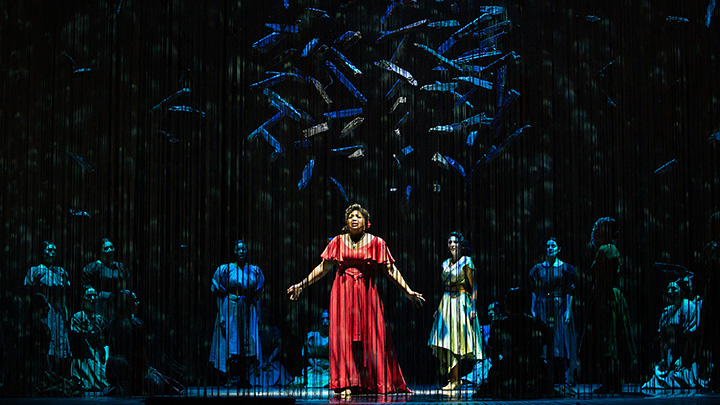
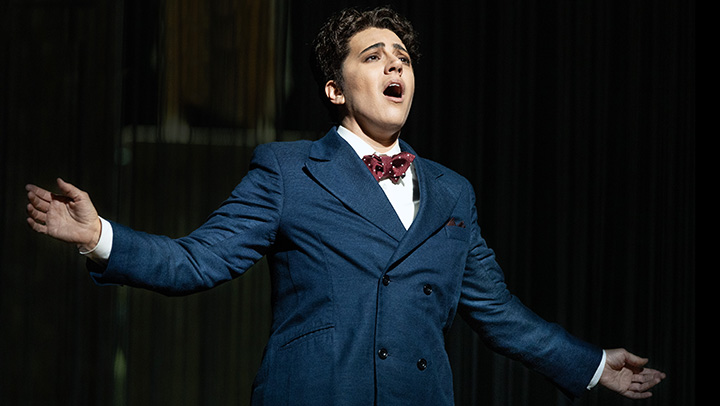
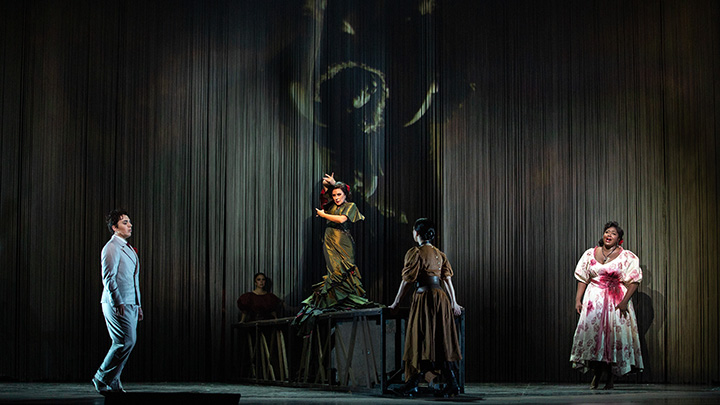

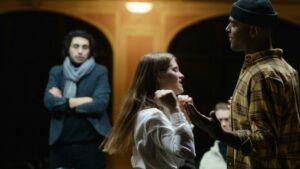
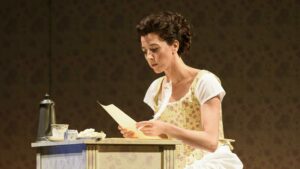


Comments